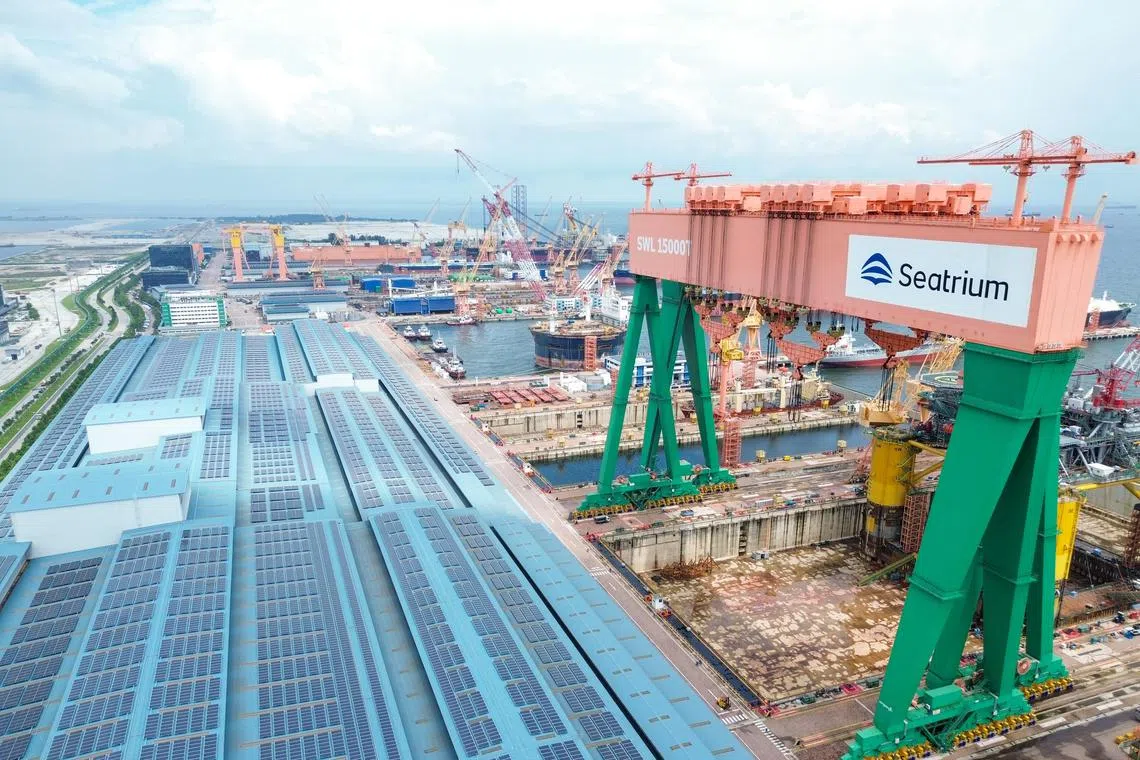1,000 job roles to be created under new plan to grow S’pore’s marine and offshore energy firms
Sign up now: Get ST's newsletters delivered to your inbox

The industry plan also encourages companies to scale internationally, while having a strong “made in Singapore” identity.
PHOTO: SEATRIUM
Follow topic:
SINGAPORE - A newly launched plan to help Singapore’s marine and offshore energy companies grow sustainably aims to create and redesign 1,000 local job roles by 2030.
Under the plan, announced on Feb 10, the industry also aims to secure new orders that facilitate at least 250 kilotonnes in annual carbon emission avoidance and reductions by 2030. This is equivalent to taking 39,000 cars off the road.
The industry plan will provide a blueprint for the sector to grow, as well as establish Singapore as the Asia-Pacific hub for maritime sustainability, said the Association of Singapore Marine and Offshore Energy Industries (ASMI).
The association launched the industry plan with support from Enterprise Singapore.
It said in a media statement: “(The plan) also aims to address challenges faced by the marine and offshore energy industry, including resource constraints, talent development and growing regional competition.
“Although the industry has long been one of the cornerstones of the nation’s economy with global leadership in marine and offshore engineering technologies and capabilities, it is essential to continuously adapt its strategies and approaches. This will ensure sustained access to long-term opportunities and foster continued economic growth.”
Manpower Minister Tan See Leng, who announced the plan in his speech at the industry’s roundtable event, said Singapore is a world-class marine and offshore energy hub with a vibrant cluster of more than 1,000 companies, comprising both globally competitive SMEs and large home-grown firms.
“As the global energy transition gathers momentum, growth opportunities abound in areas such as offshore wind. However, companies will also need to rethink their current operating models, which is largely labour-intensive and dependent on oil and gas,” he said.
“To stay ahead in such times, the only answer is to transform, just like you have done in the past. Importantly, we also want the industry to transform with a clear purpose, and with an end in mind.”
The plan aims to achieve 5 per cent average annual productivity growth to 2030. These are among four targets the plan has set for the marine and offshore energy industry.
There will be a focus on upskilling and reskilling to develop a future-ready workforce that can take on new roles in offshore renewables, sustainability, digitalisation and advanced manufacturing, ASMI said.
Another aim is to support the development of global renewable energy. This can be achieved through companies securing new contracts that contribute to the cumulative development of more than 50 gigawatts of offshore renewable energy projects globally till 2030, ASMI added.
One gigawatt can power 1.4 million Singapore households annually.
Singapore’s offshore and marine energy industry can also help to advance maritime decarbonisation, ASMI said.
This can be done through new builds and decarbonisation solutions, including retrofits and upgrades, the association noted.
ASMI president Simon Kuik said: “Singapore’s marine and offshore energy sector is at a pivotal point, with new opportunities in offshore renewables and maritime decarbonisation. To stay competitive, companies must innovate, adapt, and build new capabilities.
“This will help position Singapore as a global leader in the energy transition, strengthening its role as a key hub in the marine and offshore energy industry.”
Dr Tan said that the plan also builds on the work done as part of the earlier industry transformation map launched in 2018 for the industry. That map aimed to push the sector towards productivity-led growth and provide quality jobs for Singaporean workers.
The industry plan guides Singapore’s companies to diversify their current business portfolios by capitalising on green opportunities in offshore renewables and maritime decarbonisation.
They can leverage the partnership between the association and other organisations like the Global Wind Energy Council, so that Singapore companies can participate in international events and workshops to access global and regional offshore wind development opportunities.
The industry plan also encourages companies to scale internationally, while having a strong “made in Singapore” identity.
“For the industry to become globally competitive in new business frontiers, it is imperative that more firms expand their overseas presence,” Dr Tan said, citing examples of companies like Seatrium and Mooreast that have made their mark globally.
The companies can use the support and programmes available to them, such as Singapore pavilions organised by the association at global trade shows and business mission trips to key markets like Japan, South Korea and Europe, ASMI said.
It added that the industry plan will prioritise transformation through digitalisation, sustainability, and the development of workers.
It has a transformation initiative with Workforce Singapore that has been nurturing a growing team of marine decarbonisation and digitalisation champions within companies. More than 50 companies have benefited from this move.
“These champions will play a crucial role in helping firms transform their operations and build future-ready capabilities, ensuring they remain competitive in a rapidly evolving global landscape,” ASMI said.
Mr Soh Leng Wan, Enterprise Singapore’s assistant managing director of manufacturing, said: “The marine and offshore energy industry plan is timely, as the increasing demand on maritime decarbonisation and global push for cleaner energy will bring about new business opportunities for Singapore-based companies and Singaporeans.”
He encouraged companies to transform their operations, upskill their workers and build new capabilities.
Sue-Ann Tan is a business correspondent at The Straits Times, covering capital markets and sustainable finance.


